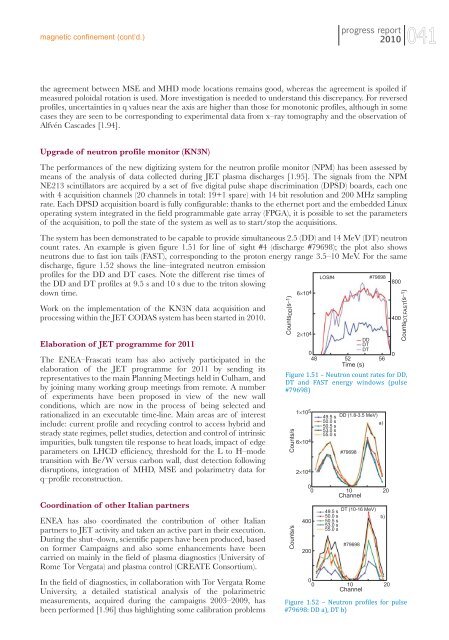Prime pagine RA2010FUS:Copia di Layout 1 - ENEA - Fusione
Prime pagine RA2010FUS:Copia di Layout 1 - ENEA - Fusione
Prime pagine RA2010FUS:Copia di Layout 1 - ENEA - Fusione
You also want an ePaper? Increase the reach of your titles
YUMPU automatically turns print PDFs into web optimized ePapers that Google loves.
magnetic confinement (cont’d.)<br />
progress report<br />
2010<br />
041<br />
the agreement between MSE and MHD mode locations remains good, whereas the agreement is spoiled if<br />
measured poloidal rotation is used. More investigation is needed to understand this <strong>di</strong>screpancy. For reversed<br />
profiles, uncertainties in q values near the axis are higher than those for monotonic profiles, although in some<br />
cases they are seen to be correspon<strong>di</strong>ng to experimental data from x–ray tomography and the observation of<br />
Alfvén Cascades [1.94].<br />
Upgrade of neutron profile monitor (KN3N)<br />
The performances of the new <strong>di</strong>gitizing system for the neutron profile monitor (NPM) has been assessed by<br />
means of the analysis of data collected during JET plasma <strong>di</strong>scharges [1.95]. The signals from the NPM<br />
NE213 scintillators are acquired by a set of five <strong>di</strong>gital pulse shape <strong>di</strong>scrimination (DPSD) boards, each one<br />
with 4 acquisition channels (20 channels in total: 19+1 spare) with 14 bit resolution and 200 MHz sampling<br />
rate. Each DPSD acquisition board is fully configurable: thanks to the ethernet port and the embedded Linux<br />
operating system integrated in the field programmable gate array (FPGA), it is possible to set the parameters<br />
of the acquisition, to poll the state of the system as well as to start/stop the acquisitions.<br />
The system has been demonstrated to be capable to provide simultaneous 2.5 (DD) and 14 MeV (DT) neutron<br />
count rates. An example is given figure 1.51 for line of sight #4 (<strong>di</strong>scharge #79698); the plot also shows<br />
neutrons due to fast ion tails (FAST), correspon<strong>di</strong>ng to the proton energy range 3.5–10 MeV. For the same<br />
<strong>di</strong>scharge, figure 1.52 shows the line–integrated neutron emission<br />
profiles for the DD and DT cases. Note the <strong>di</strong>fferent rise times of<br />
LOS#4 #79698<br />
the DD and DT profiles at 9.5 s and 10 s due to the triton slowing<br />
800<br />
down time.<br />
6×104<br />
Work on the implementation of the KN3N data acquisition and<br />
processing within the JET CODAS system has been started in 2010.<br />
Elaboration of JET programme for 2011<br />
The <strong>ENEA</strong>–Frascati team has also actively participated in the<br />
elaboration of the JET programme for 2011 by sen<strong>di</strong>ng its<br />
representatives to the main Planning Meetings held in Culham, and<br />
by joining many working group meetings from remote. A number<br />
of experiments have been proposed in view of the new wall<br />
con<strong>di</strong>tions, which are now in the process of being selected and<br />
rationalized in an executable time-line. Main areas are of interest<br />
include: current profile and recycling control to access hybrid and<br />
steady state regimes, pellet stu<strong>di</strong>es, detection and control of intrinsic<br />
impurities, bulk tungsten tile response to heat loads, impact of edge<br />
parameters on LHCD efficiency, threshold for the L to H–mode<br />
transition with Be/W versus carbon wall, dust detection following<br />
<strong>di</strong>sruptions, integration of MHD, MSE and polarimetry data for<br />
q–profile reconstruction.<br />
Coor<strong>di</strong>nation of other Italian partners<br />
<strong>ENEA</strong> has also coor<strong>di</strong>nated the contribution of other Italian<br />
partners to JET activity and taken an active part in their execution.<br />
During the shut–down, scientific papers have been produced, based<br />
on former Campaigns and also some enhancements have been<br />
carried on mainly in the field of plasma <strong>di</strong>agnostics (University of<br />
Rome Tor Vergata) and plasma control (CREATE Consortium).<br />
In the field of <strong>di</strong>agnostics, in collaboration with Tor Vergata Rome<br />
University, a detailed statistical analysis of the polarimetric<br />
measurements, acquired during the campaigns 2003–2009, has<br />
been performed [1.96] thus highlighting some calibration problems<br />
Counts DD (s–1)<br />
2×10 4<br />
0<br />
48<br />
DD<br />
DT<br />
DT<br />
52 56<br />
Time (s)<br />
400<br />
0<br />
Counts DT,FAST (s –1 )<br />
Figure 1.51 – Neutron count rates for DD,<br />
DT and FAST energy windows (pulse<br />
#79698)<br />
Counts/s<br />
Counts/s<br />
1×105<br />
6×10 4<br />
2×104<br />
0<br />
0<br />
400<br />
200<br />
49.5 s DD (1.8-3.5 MeV)<br />
50.0 s<br />
a)<br />
50.5 s<br />
53.0 s<br />
55.0 s<br />
#79698<br />
10 20<br />
Channel<br />
49.5 s<br />
DT (10-16 MeV)<br />
50.0 s<br />
b)<br />
50.5 s<br />
53.0 s<br />
55.0 s<br />
#79698<br />
0<br />
0 10<br />
Channel<br />
Figure 1.52 – Neutron profiles for pulse<br />
#79698: DD a), DT b)<br />
20













